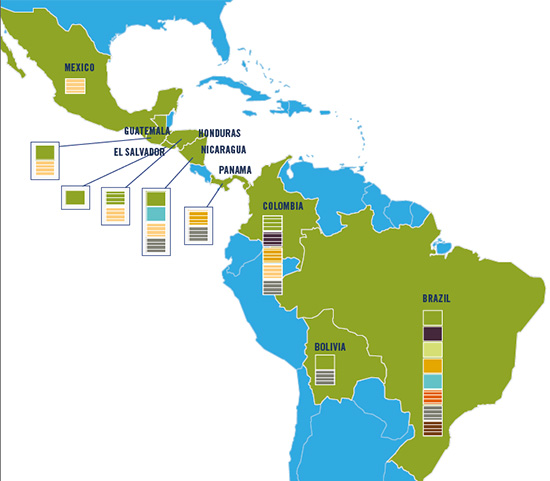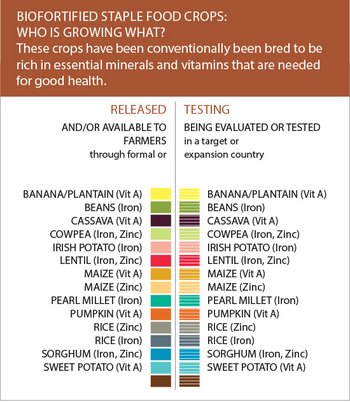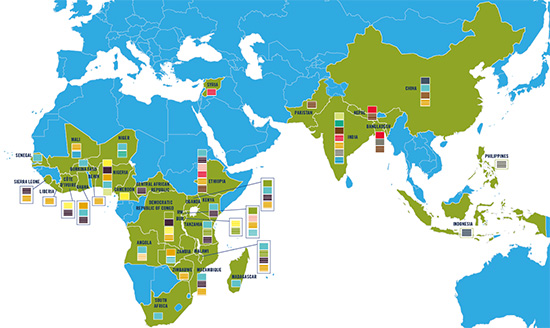 Download this article in magazine layout
Download this article in magazine layout
- Share this article
- Subscribe to our newsletter
Completing the revolution through biofortification
In a perfect world, we would all enjoy a diverse diet, one that provides all the nutrients our bodies need to be healthy and to function properly. We would have regular access to fruits, vegetables, and meat – a balanced diet that includes macronutrients (proteins, carbohydrates, fats) and micronutrients (vitamins and minerals). But our world, of course, is nowhere near perfect. Nutritional deficiencies are widespread. Micronutrient deficiencies, or hidden hunger, affect one-third of the world’s population – some two billion people.
Hidden hunger’s most vulnerable victims are the poor in developing countries, whose daily diets usually consist of a few staple food crops such as rice, maize, and cassava. These crops provide lots of energy to their consumers, but practically nothing else of nutritional worth. The deficiency in critical vitamins and minerals means populations reliant on such diets face increased susceptibility to infections and disease, and impaired mental and physical development among children. The burden is not just on individuals; economies suffer, too, as a result of lost productivity and economic growth. India, for example, loses over twelve billion US dollars in GDP annually due to vitamin and mineral deficiencies.
In such a nutritionally imperfect world, what hope is there that a major global problem like hidden hunger can be solved? Nutrition interventions have typically encompassed supplementation and fortification to provide at-risk populations with missing micronutrients. The perfect scenario, then, would be for supplements and fortified foods to penetrate to every corner of society, leaving no one behind. Sadly, due to affordability and accessibility constraints, significant numbers of people – particularly those in rural, hard-to-reach areas – fall through the cracks of these interventions. Thankfully, a new and complementary approach is now available that aims to plug that gap. Biofortification might be a recent addition to the nutrition-intervention pool, but it is the perfect fit for populations engaged in or dependent on agriculture, such as those often missed by the other interventions. Through conventional breeding, biofortification improves the nutritional content of the staple foods that these populations consume day in, day out. Farmers and their families grow and consume these crops over and over, and in the process improve their nutritional status for free. From iron-rich pearl millet in India’s Maharashtra state to vitamin A-enhanced cassava in Nigeria, biofortified crops are bringing hope to millions of people who often are at the periphery of major nutrition interventions.
Thankfully, a new and complementary approach is now available that aims to plug that gap. Biofortification might be a recent addition to the nutrition-intervention pool, but it is the perfect fit for populations engaged in or dependent on agriculture, such as those often missed by the other interventions. Through conventional breeding, biofortification improves the nutritional content of the staple foods that these populations consume day in, day out. Farmers and their families grow and consume these crops over and over, and in the process improve their nutritional status for free. From iron-rich pearl millet in India’s Maharashtra state to vitamin A-enhanced cassava in Nigeria, biofortified crops are bringing hope to millions of people who often are at the periphery of major nutrition interventions.
That hope is crystallised by the results of recent studies that demonstrate the nutritional and health impact of biofortified crops. Iron-rich pearl millet was found to have reversed iron deficiency among Indian school children within six months. In Africa, vitamin A-rich orange sweet potato reduced both the prevalence and duration of diarrhoea among young children studied in Mozambique. HarvestPlus, a programme promoting biofortified crops globally, continues to study and produce evidence on their impact as it scales up delivery efforts in Africa, Asia, Latin America, and the Caribbean. It expects at least 15 million farming households – some one hundred million people – growing and consuming these nutritious crops by 2020.

Beyond their nutritional and health purpose, biofortified crops are also deliberately bred to have superior or desired agronomic qualities compared with non-biofortified varieties. In addition to resistance to threats such as pests, diseases, heat, and drought, all biofortified crops provide farmers with high yields. In that sense, biofortification brings the Green Revolution full circle by matching the increased productivity of staple crops with increased nutritional quality. As HarvestPlus founder Howarth Bouis notes, biofortification returns agriculture to its fundamental purpose to nourish people.
For more information, see: www.harvestplus.org
Denis Okello - Communications Specialist with HarvestPlus Washington D.C., USA
D.Okello@cgiar.org





Add a comment
Be the First to Comment